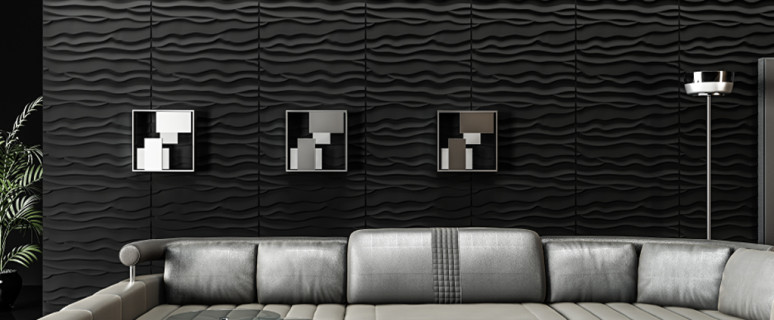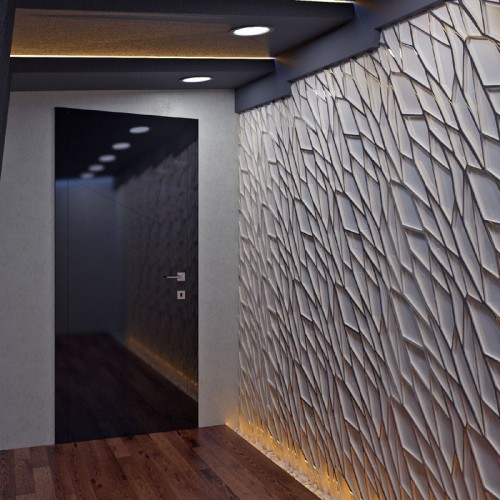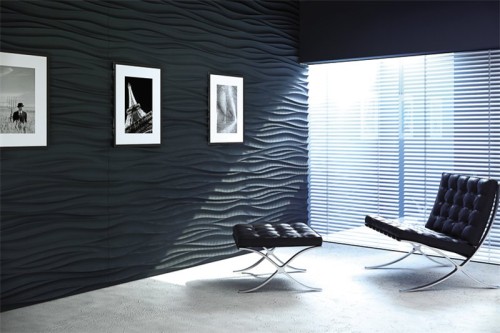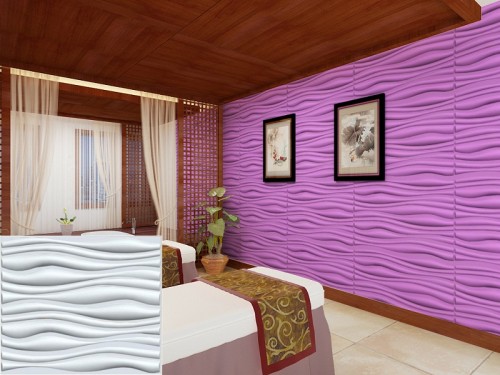
Gypsum wall panels: Installation instructions Building materials

Today there are many finishing materials. Some of them are gypsum panels for walls. On the peculiarities of this finishing material and nuances of its installation and will be discussed in our article.
Content
Characteristics of gypsum panels
This finishing material for walls is environmentally friendly. It does not burn and does not support the combustion process. The panels include such components:
- gypsum;
- plasticizer;
- polymer fibers (for reinforcement).
Compared to other decorative materials designed to finish the walls, additives containing styrene, formaldehyde or phenol are not used in the production of gypsum panels.
Gypsum 3D wall panels possess the following characteristics:
- good moisture resistance;
- excellent sound insulation properties;
- resistant to temperature differences;
- long operational period;
- a small mass (tile measuring 0.5 * 0.5 m weighs up to 5 kg);
- easy processing.
Decorative gypsum panels are distinguished by a wide variety of reliefs and textures. This fact and the ability to paint the finishing material in different colors will satisfy many creative people who will make new shades in any room for several hours.
Among the advantages of using gypsum panels for walls should be mentioned that:
- on the finished surface there are no mounting seams;
- panels do not attract dust (and this will greatly facilitate the process of care);
- the finishing material can be restored using sandpaper and finishing putty;
- there is no need to stick walls when laying wiring (it is attached behind panels).
Thanks to the walls of the walls with gypsum panels in the residential room, natural moisture adjustment occurs. In crude weather, the material absorbs moisture, and on hot days the plaster gives moisture back.
The disadvantages of installation of plaster 3D panels include:
- Low strength of the material. With independent manufacture of panels, this problem is solved by adding a polymer additive or fiber plaster.
- Careful preparation of the foundation. There should be no uneven angles and drops on the surface. Otherwise, the drawing and seams of the panels will begin to "disperse."
Selection of material
Some manufacturers produce round and oval gypsum panels. But most often there are rectangular and square products. Their dimensions may be different: the length with a width is from 0.2 * 0.2 m to 0.9 * 0.6 m, the thickness is 18-36 mm.
Also panels are divided depending on the type of sketches. They can:
- imitate natural components (wood, stone);
- create volumetric artistic paintings;
- present a mosaic, bas-relief or combined variant (single element combined with a specific pattern);
- considerate large modules that have a geometric shape with a repeated pattern in a vertical or horizontal plane.
When purchasing gypsum panels, the area of \u200b\u200bthe room plays a primary role. It is recommended that finishing works are carried out in the rooms where:
- the length of the walls is not more than 10 m;
- the wall area does not exceed 40 m².
If the wall dimensions are larger, then between several adjacent plates will have to create compensation seams. Only so can be prevented by cracking the surface as a result of temperature differences.
Branded products always contains the instructions in which the number of panel elements is indicated. Of these, both one specified drawing can be folded as well as several images. Moreover, the connection of the panels can be carried out in completely different ways.
The same applies to the installation of gypsum panels. Not necessarily on the wall to create a solid coating. Material laying can be carried out by vertical, horizontal or diagonal stripes.
The only discrepancy factor when purchasing gypsum panels is the high cost of finishing material. But this problem is solvable. Gypsum panels can be made at home.
Manufacturing panels
In order for the gypsum 3D panels for walls in the photo and in reality, it is necessary to take into account a number of requirements. In most cases, they relate to work with the source material, referred to as the plaster.
Gypsum is a fine powdery substance, which includes calcium sulfate. In contact with water, crystals are formulated.
The main characteristics of the gypsum are:
- the magnitude of the grinding;
- grappling rate.
To create small decor elements, a small grinding gypsum is used. When carrying out other construction work, finishing material of coarse grinding is used. As for the rate of grasp gypsum, then slowly frozen material is suitable for the manufacture of finishing solutions. The panels are made of plaster, which grasps much faster.
When working with plaster, the following features should be taken into account:
- The timing time is 7-10 minutes. For this reason, the solution does not need to be made with a margin.
- The specific volume of the finished solution is determined by summing up the amount of dry mixture and water.
- It is forbidden to change the consistency of the finished solution, which began to be seized by adding a powder or water. Such material will be characterized by low strength and viscosity.
For the manufacture of the finished mixture, the following components will be needed:
- gypsum G5 (8 hours);
- lime (1 h.);
- water (7 hours);
- fiber Owlock (1% of the amount of gypsum).
The process of production of gypsum panels provides such sequence of actions:
- lime and fiber fiber is hidden into the container;
- they are filled with water;
- the mixture is thoroughly mixed with a drill equipped with a mixer with a mixer;
- gypsum is poured into the solution;
- the mixture is stirred to "sour cream" consistency;
- the solution should not contain lumps;
- the finished mixture is bottled in forms;
- forms are mounted on the surface that should be susceptible to vibration;
- for 30-35 minutes, vibration of forms with plaster occurs;
- the panels are extracted from the forms and are dried in a special chamber or simply on the street.
Mounting work
Installation of gypsum panels precedes the preparation of walls:
- all irregularities are removed;
- put off and plaster slots;
- the surface is grouped by sandpaper.
After the preparatory work:
- walls are covered with primer;
- after drying the primer, the horizontal and vertical planes are marked;
- the reverse side of the panel is drained by glue;
- in accordance with the marking of the panel are strongly pressed against the wall;
- the finishing material should be perfectly clung to the surface;
- there is a small gap between adjacent panels;
- the last panels are adjusted in size by cutting;
- to cut panels, use ordinary hacksaw;
- joints are closed with putty;
- excess putty is removed by a wet sponge;
- after drying, the seams are grained fine-grained emery paper;
- the surface is frozen finishing putty.
In principle, the installation of plaster 3D panels can be carried out on a plasterboard surface. In this case, on the one hand, there is no need for preliminary preparation of walls. On the other hand, plasterboard will not be able to withstand a large load. Therefore, you will have to acquire or independently produce plaster panels with minimal dimensions.
Painting panels
At the final stage, staining new walls. Gypsum panels are covered with a special primer intended for mineral coating. After its drying, 2-3 layers of water-emulsion paint occurs. Optionally, you can add dyes of any shade in the paint.
After drying, the paint panel can be coated with a solution of silicone mixed with water. Due to this, the gypsum panels will become the most resistant to the effects of moisture and pollution.
As an alternative to silicone impregnation, quick-drying varnish can be used. 2-3 layers of matte or glossy varnish on a water basis should be applied. Gypsum 3D panels will get shine and more rich color. Also, the lacquer layer will make it possible to carry out wet cleaning.
Video on the mounting of gypsum panels:























